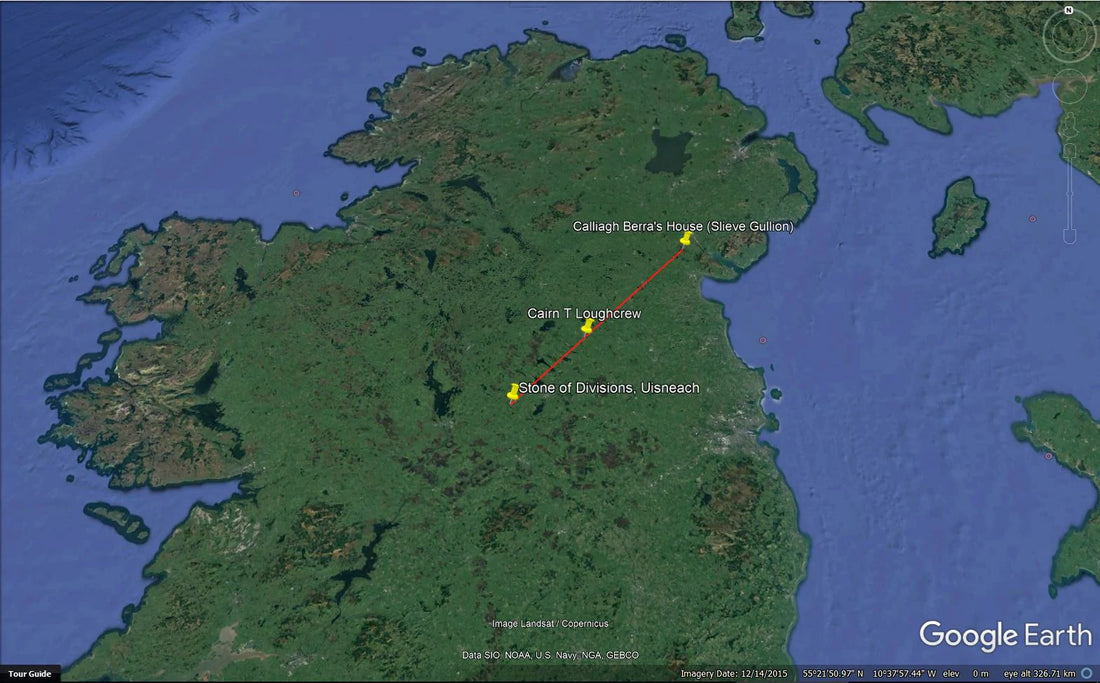
Video: The incredible accuracy of an ancient solstice alignment of Uisneach, Loughcrew and Slieve Gullion
In 1992, it was suggested that the sacred site of Uisneach, the traditional "centre" of Ireland located in present-day Westmeath, was aligned with the Loughcrew megalithic complex and Slieve Gullion for summer solstice sunrise. Anthony Murphy investigates the remarkable accuracy of this 63-mile alignment using Google Earth.
In his 1992 book Mythic Ireland (later republished as Ireland: A Sacred Journey in 2000), author Michael Dames claimed that there was a series of ancient alignments of sacred sites radiating from the hill of Uisneach, which marked the location of Mide, the notional fifth province of Ireland, unifying the others – Ulster to the north, Leinster to the east, Connacht to the west and Munster to the south. One of these alignments involved a sightline towards the megalithic complex at Loughcrew and, in the far distance, Slieve Gullion in Co. Armagh, looking towards the summer solstice sunrise.
Using Google Earth, which is free software, we can see not just that this alignment is present, but in fact how extraordinarily accurate it is. Google Earth has a great tool called the ruler. Using the ruler, you can draw a straight line across the surfact of the earth between two points. (This "line" is in fact an arc, following the curvature of the earth.)

Looking at Dames' proposed summer solstice alignment from Uisneach towards Gullion, I used the Google Earth ruler tool to plot a line from the Stone of Divisions (Aill na Mireann, also known as the Cat Stone) towards the Calliagh Berra's House, a Neolithic chambered cairn near the summit of Slieve Gullion, some 63.8 miles (103 kilometres) distant.
I'm not sure what methods Dames used to calculate the proposed alignments from Uisneach, but I wonder just how impressed he would be to see how amazingly accurate this Uisneach-Gullion alignment is.

It passes directly through Cairn T on the summit of Slieve na Calliagh in Loughcrew. It does not skirt the cairn to the north or the south, but rather intersects it precisely. In other words, over a distance of almost 64 miles, the Stone of Divisions at Uisneach is aligned with Cairn T and Calliagh Berra's House precisely, and that this is the direction in which the sun rises on summer solstice. Conversely, the winter solstice sun sets over Uisneach and Cairn T when viewed from the Calliagh Berra's House. In fact, it is well known that an observer in the chamber of Calliagh Berra's House on Slieve Gullion on winter solstice will see the sun setting in the direction of Loughcrew.

The Stone of Divisions is huge limestone boulder, believed to have been an erratic rock left behind by the glaciers during the last ice age. Uisneach is a complex of monuments and sacred sites. It is associated with Eriu, the Tuatha Dé Danann sovereignty goddess who have her name to Ireland (Éire). It is also associated with Dagda (Eochaid Ollathair), the chief deity of the Dé Dananns. Tradition also says that Saint Patrick visited Uisneach.
The Stone is located on the southwestern slope of Uisneach hill and therefore Slieve Gullion is not visible from the stone, as Dames suggests. However, I have written quite a bit about ancient long-distance alignments of ancient sites in which some of the monuments are not intervisible. A great example is the Newgrange-Fourknocks winter solstice alignment. Fourknocks is not visible from Newgrange due to intervening hills.
A reat annual oenach or gathering took place at Uisneach in ancient times on the festival of Bealtaine:
It was at Bealltine that this fair took place, at which it was their custom to exchange with one another their goods, their wares and their valuables. They also used to offer sacrifices to the chief god they adored, who was called Beil, and it was their wont to light two fires in honor of Beil in every district in Ireland, and to drive a weakling of each species of cattle that were in the district between the two fires as a preservative to shield them from all diseases during that year.(1)
The ancient gathering at Uisneach at Bealtaine has been reinstituted in the past six years, with a fire festival. It's taking place next Saturday, 5th May. I'm looking forward to going and to seeing some of you there.

(1) Keating, quoted in Dames (2000).
